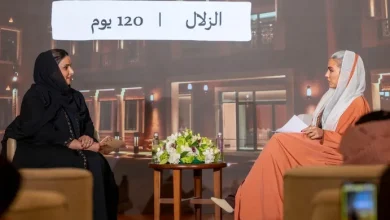INTERVIEW: Ibrahim Al-Almaai on Three Decades of Preserving Al-Qatt Al-Asiri

Al-Qatt Al-Asiri, a vibrant traditional art in the Asir region, is not just an art form but a living testimony to the heritage and creativity of Asir community.
Once practiced traditionally by women inside homes, the art’s geometric patterns and vivid colors have become a symbol of cultural pride.
In 2017, Al-Qatt Al-Asiri earned recognition by UNESCO as Intangible Cultural Heritage, gaining more international interest and local support.
Saudi visual artist Ibrahim Al-Almaai has devoted more than three decades of his life to documenting, preserving, and reviving this stunning art form.
Al-Almaai’s journey across the villages of Asir has not only safeguarded countless examples of this unique art but also deeply shaped him and boosted his appreciation of Saudi Arabia’s cultural heritage.
In this exclusive interview with Leaders MENA Magazine, the Saudi visual artist, Ibrahim Al-Almaai, shares his three-decade journey of documenting and preserving Al-Qatt Al-Asiri, reflecting on its cultural significance, the challenges he faced, and his vision for safeguarding this heritage for future generations.
Interpretation of Al-Qatt Al-Asiri

Q: Al-Qatt Al-Asiri has many interpretations and cultural significances. How would you describe this artform in your own words and through your personal lens?
The meanings and interpretations of Al-Qatt Al-Asiri vary across the different areas of the Asir region. Its patterns often carry local names that offers a vivid image of each community. At the same time, many villages in the region create Al-Qatt Al-Asiri designs purely for their beauty, without attaching specific symbolic meanings to them.
Q: Do you believe that there is a deeper social meaning behind this art since it has traditionally been practiced by women?
As human beings, we are naturally attracted to art and to the constant presence of beauty around us. For me, that was the urge for decorating homes — to complete the sense of beauty both inside and outside the house. The close connections between families and neighbors, along with the gatherings we share on special occasions, also played a key role in spreading this art until it became an integral part of our daily lives.
Inspiring Journey

Q: What inspired you to focus particularly on Al-Qatt Al-Asiri art and devote more than three decades in documenting this deeply rooted traditional artform?
What drew me to this art was basically its beauty and diversity. But at the same time, I saw it began to fade away, a fact that made me determined to document it, uncover its secrets, and preserve its cultural heritage for future generations.
Q: This vibrant Asiri Wall painting features vivid patterns, colors and symbols. Could you please explain what they represent?
Al-Qatt Al-Asiri art doesn’t necessarily require bright colors as artists have the freedom to use whichever colors they choose. As for the symbols and patterns, some people name them based on shapes they see in their environments, while others do not pay great attention to names and focus instead on the aesthetic beauty of these patterns.
Al-Qatt Al-Asiri & Social Values
Q: How does Al-Qatt Al-Asiri serve as a visual representation of the Asir region’s social values, traditions, and daily life?
This art represents a vital part of the heritage of the Asir region in particular, and of the south in general. However, many people stopped practicing Al-Qatt Al-Asiri, and it began to fade away like other traditional arts.
Perilous Journey

Q: What were the most significant obstacles you faced during your efforts to document Al-Qatt Al-Asiri?
Documenting Al-Qatt Al-Asiri has never been an easy journey. Spread across a wide geographical area, the art has been challenging to locate and access in the places where it still survives
Moreover, gaining access to private homes and old fortresses was often difficult — sometimes because the owners refused entry, and other times because the buildings were so dilapidated that entering them posed a real risk of falling or being trapped in a collapse.
Another challenging part of the process is that I had to return to the same locations more than once to re-document the art for various reasons.
UNESCO’s Recognition

Q: What was your personal reaction when Al-Qatt Al-Asiri was recognized in 2017 by UNESCO as Intangible Cultural Heritage?
I was, of course, very proud of UNESCO’s recognition. The move felt like a significant milestone in honoring the work of generations who created an outstanding artistic identity that we can proudly share with the whole world. It also reassured me that Al-Qatt Al-Asiri, passed down from one generation to the next, will not be forgotten and will not become a mere memory.
After such an important recognition, I had hoped that the authorities would take swift moves to restore the houses that preserve this art and transform them into cultural and tourist hubs.
These sites could have stood as testaments to the authenticity and beauty of Al-Qatt Al-Asiri, while also offering researchers a space to continue their studies and ensure the art’s survival.
Community Role

Q: In your view, what practical steps can organizations and individuals take to ensure the survival of Al-Qatt Al-Asiri and the traditional skills it embodies?
The current reality shows that Al-Qatt Al-Asiri is very much alive, with many new talents joining their ancestors who creatively practiced this art.
By organizing specialized courses, workshops, and exhibitions, we can safeguard this artform, simplify its teaching process, and explore its authentic details.
It is also crucial to emphasize that it is a traditional art form whose beauty and creativity emerge basically from the spirit of both the male and female artist.
Cultural Reflections

Q: Having dedicated almost thirty years to visiting villages across Saudi Arabia and capturing the essence of this spontaneous art form, this journey must have deeply shaped you. What insights has it given you as both a Saudi and an artist?
That is really a profound question — one that really makes me pause, because my journey with Al-Qatt Al-Asiri and its impact on me as both a person and an artist could fill volumes.
Simply, this journey has deepened my admiration and appreciation for the Kingdom’s rich heritage, traditions, and art. This exceptional heritage makes us all proud of our ancient history and confident about our future, particularly with the vision and support of our wise leadership.
Through this long journey of documenting Al-Qatt Al-Asiri, I discovered that it represents, above all, a form of absolute freedom.
I came to realize this after experiencing a wide range of Al-Qatt models, each with its own unique rules and formations.
This experience completely changed my early belief that the art followed fixed patterns, revealing to me its boundless creativity and limitless possibilities.
Childhood Spark

Q: To what extent have family traditions or oral histories influenced your choice to concentrate on documenting Al-Qatt Al-Asiri?
There were no particular stories or traditions connected to Al-Qatt in my family. This art attracted my attention for the first time when I was eleven years old. I remember standing in our home, known to many as the Palace of Diriyah in the village of Rijal, Rijal Almaa province, and being completely captivated by the walls around me.
What truly astonished me was the richness of detail, the harmony of colors, as well as the beauty of the patterns.
So, from that moment, I became not only an admirer, but also a seeker, a practitioner, and ultimately a lifelong lover of this art.
Safeguarding Heritage

Q: Through your enduring journey in preserving and documenting this traditional artform, what core message do you hope to communicate?
The core message I wish to convey to both the community and the relevant authorities is the importance of preserving Al-Qatt Al-Asiri by intensifying efforts in training and education, as well as by supporting and encouraging its practitioners.
Similarly, we should raise awareness of this remarkable visual heritage, both locally and internationally.
I also hope that serious measures will be taken to preserve the remaining authentic examples of this art, still found in old houses and fortresses, many of which have been damaged or lost due to the factors of time and lack of maintenance.
Related Topics:
Saudi Artist Devotes Life to Documenting Al-Qatt Al-Asiri Art
Wrth Preserves Al-Qatt Al-Asiri Art through Training Program
Wrth, King Abdulaziz Library Host Symposium on Saudi Handicrafts





